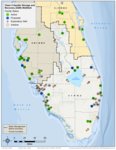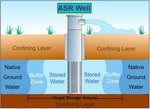Water quality is also a concern. Without the slow sheetflow through vegetation to clean the stormwater
Join our family of readers for as little as $5 per month and support local, unbiased journalism.
Already have an account? Log in to continue. Otherwise, follow the link below to join.
Please log in to continue |


The South Florida Water Management District and the U.S. Army Corps of Engineers are moving forward in a phased, studied approach to the use of aquifer storage and recovery (ASR) wells to slow the flow of water into Lake Okeechobee.
Why storage is needed
The flood control structures that made it possible for millions of humans to live in areas of South Florida that were once underwater part of the year also created problems with both water quantity and quality. Prior to flood control, water that fell in the northern Everglades watershed (which starts at Shingle Creek near Orlando) took about six months to slowly sheetflow south over vast floodplains into Lake Okeechobee. Thanks to the ditching and diking projects that now protect developed areas from seasonal flooding, water drains rapidly into Lake Okeechobee. Instead of moving slowly in a sheetflow over six months – with vegetation cleaning the water along the way and some water percolating into the earth to recharge the aquifer or evaporating into the air – stormwater is rapidly funneled into the Kissimmee River and south to Lake O.
Instead of six months, that hydrological trip may take just three weeks. As a result, in the wet season water often flows into the lake six times faster than it can be released to the south, which can result in the harmful freshwater releases east and west.
Water quality concerns
Water quality is also a concern. Without the slow sheetflow through vegetation to clean the stormwater, water enters the lake high in phosphorus. Data from the SFWMD and Florida Department of Environmental Protection (DEP) link spikes in the amount of phosphorus entering the lake directly to the volume of water flowing into the lake from the north.
At the April 2017 Lake Okeechobee Basin Management Action Plan meeting, Frank Nearhoof, DEP, explained “the flow drives the (nutrient) load.” He said 90 percent of the water flowing into Lake Okeechobee comes in during a very short period of time. Most of the time there is very little flow into the lake, he said, but 10 percent of the time there are rapid flows. That 10 percent of the time is also responsible for 60-70 percent of the total phosphorus going into Lake Okeechobee.
This is the key to restoring the lake, Mr. Nearhoof said. “If we can’t detain this flow, we are doomed to failure.”
The 2015 University of Florida Water Institute study called for extensive water storage north, south, east and west of Lake Okeechobee:
• 400,000 acre-feet of water storage within the Caloosahatchee River watershed,
• 200,000 acre-feet of water storage within the St. Lucie River watershed; and
• Approximately 1 million acre-feet of water storage distributed north and south of Lake Okeechobee.
The C-43 reservoir is under construction west of the lake and the C-44 reservoir is under construction east of the lake. South of the lake, the Everglades Agricultural Area (EAA) reservoir stormwater treatment area (STA) is under construction and the EAA reservoir, which will provide about 240,000 acre feet of storage, is on track to for the corps approve a construction contract by the end of the year.
Northern storage is the missing piece of the puzzle.
The Comprehensive Everglades Restoration Plan (CERP) approved by Congress 20 years ago, includes the use of ASRs to provide part of the much-needed storage north of the lake.
ASR is proven technology
ASR refers to the process of recharge, storage, and recovery of water in an aquifer. ASR facilities have been used in Florida and throughout the United States for about 40 years. There are more than 30 ASR systems currently operating throughout the state, utilizing approximately 100 wells for recharge, storage, and recovery. In Florida, ASR systems are currently used for the storage of potable drinking water, partially treated surface water, groundwater, and reclaimed water.
ASRs take water that has been treated to drinking water standards and pump it into an aquifer through a well. When the water is needed, the water can be pumped back out. The rate of water recovery from the ASRs varies in the system. Wells closer to Lake Okeechobee appear to do better than those in some other areas. A test well on the Kissimmee River had a nearly 100% recovery rate.
Most ASR facilities in Florida store water in the upper Floridan Aquifer, primarily in areas where the aquifer is brackish or somewhat salty. The clean, treated water makes a “bubble” in the aquifer where the water stays until it is pumped back out.
According to SFWMD, ASR technology offers the potential to store large quantities of water without the need for expansive tracts of lands that would be required for above ground storage facilities. An ASR system can also store and then return large volumes of water over long periods of time, increasing water supplies during seasonal and multi-year droughts.
CERP, authorized by Congress in 2000, provided a framework to “restore, preserve, and protect the south Florida ecosystem while providing for other water-related needs of the region, including water supply and flood protection.” One of the primary storage technologies proposed in the CERP is ASR.
Implementing the CERP ASR plan required that some uncertainties be resolved prior to expansion of the technology. The CERP ASR pilot projects were initiated to resolve technical uncertainties prior to full ASR implementation envisioned in CERP.
Two ASR systems (Kissimmee River and Hillsboro) were constructed and tested to evaluate ASR feasibility at locations where ASR storage could be expanded in the future. The Kissimmee River ASR system was designed, constructed, and operationally tested by the corps. The Hillsboro ASR system was designed, constructed, and operationally tested by SFWMD. Successful completion of cycle tests at both ASR facilities found ASR technology is a feasible storage alternative for excess surface water flows at these geographic locations.
National Research Council recommended a phased plan. Although ASR technology has been used successfully in Florida since 1983, concerns were raised about the large-scale application of ASR as envisioned in the CERP. In 2015, the National Research Council (NCR) reviewed the ASR Regional Study Technical Data Report. Their findings concluded that CERP ASR should move forward in a phased implementation, while continuing to address some remaining uncertainties.
To address these uncertainties, the SFWMD and the corps developed a Final Draft 2021 ASR Science Plan, describing potential studies to be conducted as ASR wells are implemented in a phased manner. The ASR Science Plan was developed with review and input from an independent peer-review panel of scientists. The ASR Science Plan presents the first version of an overarching program of scientific studies that will support a phased ASR implementation schedule for the Lake Okeechobee Watershed Restoration Project (LOWRP). These studies have value anywhere ASR wells are proposed and can be used to address ASR uncertainties associated with other CERP and non-CERP projects.
The panel of scientists will meet annually to review the investigations’ findings and provide guidance on additional studies. The ASR Science Plan is “intended to be a living document based on the best information available at the time of update. The proposed scope, schedule, and budget for ASR Science Plan studies are subject to change as the ASR program progresses and additional information becomes available.”
Lake O Watershed Restoration Project - The 2021 ASR Science Plan supports a phased ASR implementation schedule for the Lake Okeechobee Watershed Restoration Project (LOWRP). LOWRP includes 80 ASR wells with a storage volume of approximately 448,000 acre-feet per year; a 46,000-acre-foot wetland attenuation feature (shallow impoundment); and restoration of two wetland areas adjoining the lower reach of the Kissimmee River (C-38 Canal). As a part of CERP, LOWRP will be funded with a 50/50 cost share with state and federal funding.
The price tag for LOWRP is about $2 billion. Of that total, about $400 million is for 80 ASR wells. According to information shared at the SFWMD meeting, the ASR wells are the most cost-effective method to store water. In 2019 and 2020, the Florida Legislature allocated a total of $100 million to “jump start” the northern storage project.
The ASR Science Plan contains an in-depth evaluation of available technologies for achieving regulatory compliance while minimizing operations and maintenance costs.
The plan calls for:
• Core drilling in 2021 to better understand the geology in areas proposed for ASRs;
• Reactivation of existing ASR systems in 2021 and 2022;
• Resting and exploratory multi-wells in 2021-2022;
• Well design and permitting, 2021-2023;
• Initial cycle testing, 2024-2026;
• Extended testing and wellfield expansion, 2026-2030.
The Final Draft 2021 ASR Science Plan is available for 30-day public review at https://www.sfwmd.gov/sites/default/files/2021_draft_asr_science_report_main.pdf. Public comments can be submitted through March 7, 2021, via email, ASRWells@sfwmd.gov.